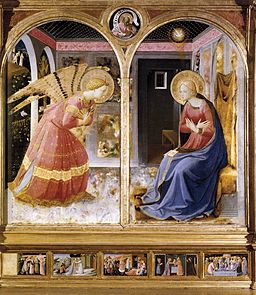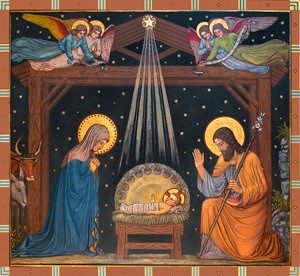Advent - Year B
A collection of Advent and Christmas resources including sermon ideas, entire sermons, songs, prayers, and more.
Advent Resources 2023
Quick Links
View our collection of Advent resources and Christmas resources as well as trusted content from around the web. The current week’s Sermon Commentaries on all four of the Lectionary passages are available every Monday. Looking for resources on other passages? Check out our abundant and easy-filter Library.
Year B Reflections
The Gospel of Mark Many think it is the original Gospel to be written down and that Matthew and Luke knew of it and made use of it in composing their own Gospel accounts. After all, with the exception of just 30 verses (out of Mark’s total of 661 verses), all of Mark can be found in Matthew, Luke, or both. For Advent 2023 the first two Sundays take texts from Mark—one from near the very end and one from the very beginning. One thing we preachers know about Mark is that his writing style is very spare—Mark wastes no words and, particularly in the first part of the Gospel, events take off with lightning swiftness, motored along by Mark’s favorite Greek adverb of euthus: immediately!
Mark was in a hurry to get the story of Jesus across. And if Mark’s Gospel begins very suddenly with Jesus just emerging from out of nowhere to be baptized by John, it ends with equal suddenness in Mark 16:8 as the terrified women flee the empty tomb, hurtling out into history like projectiles emanating from a terrific explosion. Mark ends in the silence of the women but the story could never have been told had they stayed silent. We know they spoke, we know they witnessed eventually. So must we all, Mark is telling us, so must we all.
Mark is also the Gospel that is clotted with misunderstanding about who Jesus is. No one understood him, no one got Jesus’ identity and nature right, and even Jesus himself is constantly asking for silence every time someone is ready to identify him publicly as God’s Christ. Jesus knew that only his death on the cross would unlock his true identity and so once he dies and then is raised again, the angel tells the women to go to Galilee to see Jesus. But as Donald Juel, Thomas G. Long, and Ched Myers remind us, that final instruction is also a cue to us readers: we, too, need to go back to Galilee, back to Mark 1 and then re-read the Gospel. Once we have been to the cross and come to understand the true nature of Jesus as Messiah, then we can re-read the whole story through new eyes.
Scholars have arrived at two, possibly related, schools of thought as to Mark’s purpose in writing this gospel the way he did. Some think Mark’s church had been persecuted and so was feeling discouraged. Others think that by later in the first century perhaps some churches had become a bit lethargic. Either way or both ways Mark presented a gospel designed to shake people up. Mark wanted to wake up the lethargic church and he wanted to boost up the discouraged church by writing a gospel that reminded them of the dramatic power that Jesus possessed and still possesses. Hold your heads up high, Mark is saying. Don’t be the least bit blasé about the gospel, Mark is saying. We are part of a grand drama shot through with tremendous power. Take heart!
As we come to the close of another bloody year with wars raging in Ukraine and Israel/Gaza and as we prepare to turn the corner in to a year in 2024 that will be politically brutal in the United States, surely this is a message in Advent that we all need. Take heart. Be of good courage. Remember the powerful Jesus we serve! But again, we have to go all the way to the cross to get this message aright.
As we use Mark for the first half of Advent 2023, therefore, we know that Mark wants us preachers to get things right, too. We cannot rush in and glom onto Jesus with too much haste and we cannot allow preconceptions as to who Jesus is cloud our ability to come to understand who he really is. Mark does not bother with any account of Jesus’ birth—the urgency of the Gospel and the speed of Mark’s narrative demanded that we jump right to the chase of Jesus’ actual ministry. You can understand Jesus without his birth in a Bethlehem stall, Mark is saying, but you cannot understand him unless you go all the way to the cross. It goes without saying, then, that Mark would have no patience whatsoever with all things Christmasy if that means Hallmark-like sentimentality or all twinkling lights with no heavy sense for the dark seriousness that brought God’s Son to this world in flesh in the first place.
Mark would have no patience with that. Neither should we.
First Sunday in Advent Resources, December 3, 2023
Gospel Text: Mark 13:24-37

Reflection:
Most people associate Christmas with watchfulness. But to put it mildly, the watchfulness Mark 13 talks about is a far cry from children watching for a glimpse of reindeer in the sky on December 24 or the watchful expectation of children observing their parents putting packages under the Christmas tree and wondering just what might be in a box of that particular size and shape. The month of December may be about expectations and watchfulness but in the popular imagination, what we watch for are happy things: Santa Claus, reindeer, presents, family and friends we have not seen for a while pulling into the driveway for a holiday get-together.
In the tradition of the Church, Advent begins with those passages where Jesus also encourages watchfulness but what he points to would not count as cheery in the minds of most. Jesus points to the end of all things and although believers may regard that return of Jesus as a good, hopeful, and finally comforting reality to which they look forward, many in the world may be simply undone by that return. The church has always insisted that Advent begin not inside a Hallmark card but up on the windswept peak of the Mount of Olives from which Jesus pointed forward to some very ultimate and final things. This is definitely NOT the biblical equivalent of holiday Muzak playing in the background of the mall. There is no Bing Crosby wishing for a white Christmas here, no chestnuts roasting on some cozy fire. But maybe just that has been the church’s point all along–Advent is not supposed to be fluffy and sentimental.
Our culture long since forgot that. Has the church?
Second Sunday in Advent Resources, December 10, 2023
Gospel Text: Mark 1:1-8

Reflection:
Should I ever want to make the Gospel of Mark into a movie, I know what my opening camera shot would be: it would be a fuzzy, hazy picture of heat emanating off a scorching desert. The movie would begin bleakly in a place where few would care to be for long—a hot, arid, dry, dusty, thirsty place. It would begin, in other words, about as differently from most Christmas holiday specials or movies as you could imagine. Contemporary celebrations of Christmas put most of us in mind of rich buffets, butter-drenched dinners, eggnog and toddies, sweet cookies and bars that Mom and Grandma make just once a year.
Mark will have none of it. We start in the wilderness, the place where you are more likely to BE some wild critter’s dinner than find anything to eat yourself.
If the first Sunday in Advent forced us to look at the very non-Christmasy musings of Jesus in his Olivet Discourse, the second Sunday in Advent doesn’t do much better in terms of setting the “proper” mood for the season. Mark 1 takes us out into the wilderness. Mark 1:1 tells us that this is “The Beginning” of the gospel. In the Greek the first word is ARCHE, and every biblically literate person who reads this knows, as Tom Long has pointed out, that this is Mark’s way of saying “GENESIS.” This is the Genesis of all things. And even as Genesis 1:1 took us out into the wastes of the primordial chaos before God began imposing the cosmos of his good creation order, so Mark 1 takes us back to the chaos as this is symbolized all through the Bible in the wilderness, the desert, the wastelands of a fallen world. In the beginning God established cosmos overtop of primordial chaos.
But humanity allowed evil to get a foothold back in this world and the chaos had been making a comeback ever since. The wilderness is the biblical symbol and shorthand for chaos and for the power of evil. So it’s no surprise that when the gospel comes to this world, it makes its start in the wilderness. That’s where the voice of hope has to cry out. That’s where John the Baptist goes. That’s where we have to meet John if we are going to be truly and properly prepared to meet the Christ whose Advent the season is about.
Third Sunday in Advent Resources, December 17, 2023
Gospel Text: John 1:6-8, 19-28

Reflection:
The third Sunday of Advent and this lection from John 1 seems to be a kind of “via negativa” way to observe the Season. The words “not” and “no” come up a lot. “He himself was NOT the light.” “I am NOT the Christ.” “Are you the prophet?” “No!” The commentator Frederick Dale Bruner notes that in the original Greek, John the Baptist’s answers keep getting shorter and shorter:
— Verse 20: ego ouk eimi ho Christos—“I am not the Christ”
— Verse 21a: ouk eimi—“I am not” (in answer to whether he was Elijah)
— Verse 21b: ou—“No” (in answer to whether he was the Prophet)
Five words, two words, one word. All in the negative.
What are we to make of all this fuss on the Apostle John’s part to keep wrenching the Messianic spotlight away from John the Baptist? There are lots of ways one could go on this but perhaps in our contemporary context this could be a reminder that at Advent/Christmas, above all times, it is so vital to get this right. Who is the real Jesus? Who is the Christ? John the Baptist had to go out of his way to make sure no one mistook him for the genuine article. And by the time the Apostle John wrote his gospel, mistaking John the Baptist for the Christ/Messiah was apparently still such a common error that he, too, had to interrupt the soaring poetry of John 1:1-18 with that little aside in verses 6-8 to make sure everyone knew about whom John was writing all this great stuff about the Word who was with God in the beginning, etc.
Christmas has become a time when Jesus turns into Silly Putty. Everybody wants to mold him into some shape pleasing to them. Popular Christmas songs (and even a traditional Christmas Carol or two as well, alas) do this. Greeting cards and holiday TV specials and movies do this. Jesus becomes all things to all people but is he the real Christ who John the Baptist came to announce and point people to? The gospel reminds us that it’s rather important to be clear on this point!
Fourth Sunday in Advent Resources, December 24, 2023
Gospel Text: Luke 1:26-38

Reflection:
Mary was greatly troubled at the appearance of the angel and over what he had to say.
Apparently she is the only one.
The rest of the holiday season reduces the appearance of angels to the level of the mundane–it’s hard to imagine being startled by the kind of angels we see depicted in art and the like during the month of December. Most of the angels in the Bible always have to say “Fear not!” right off the bat. Today people think that the first thing an angel would be likely to say would be “Hi’ya!” What’s more, in the case of Luke 1, what the angel Gabriel goes on to tell Mary is full of wonder and mystery. But modern society has pretty well succeeded at taking the wonder out of the season.
Oh, we still have the wide-eyed wonder of the children but it’s no wonder over the MESSAGE of Advent but wonder over how incredibly pretty twinkling Christmas lights can be. Luke 1 re-orients us to the awe, the wonder, the mystery of it all. And if we want to add a little more mystery, it’s not a bad idea on the Fourth Sunday in Advent to peer ahead a few verses in Luke 1 to listen to Mary’s song in verses 46-55. Because what the angel’s message unleashed in the heart and the imagination of this young girl is nothing short of bracing!
Christmas Day Resources, December 25, 2023
Reflection:
Take your pick on Christmas Eve or Morning: you can take the cosmically wide-angle lens of John that scoops up the whole of history or the narrow-angle lens of Luke that zooms in on just a handful of people in a very tiny place in a very modest town in the middle of nowhere. God’s truth is the same in both Gospel accounts: the Son of God had become human. Any truth that is this shatteringly stunning is a strong enough truth to be considered in either a history-wide accounting like John’s opening prologue that zips readers back to the “In the beginning” of Genesis 1 or the more intimate portrait of Joseph and Mary (with a few shepherds thrown in for good measure).
If the truth of the incarnation really is the truth, then you can tell history’s grand story any old way you want and it is all going to turn out the same: everything boils down to what did or did not happen in that Bethlehem stable and to the child whom John calls the Word made flesh and whom Luke identifies as Mary’s little bundle of joy. In fact, if that all is true, then starting on that night when there was no room in the inn, you actually cannot tell history’s story accurately without making reference to the life that began via that pregnancy and birth.
In a pluralistic age of tolerance in which many people shy away from any claims that sound too broad and all-encompassing, let’s just admit that what you just read in the previous paragraph is mighty bold.
But maybe that just means that for all its glittering and twinkling charm, Christmas is not finally supposed to be about claims that are tame.
Additional Advent Resources
Christmas and Advent Audio Sermons
“God Comes to Bethlehem” by William Willimon
“Christmas Needs to Get More Materialistic“ by Samuel Wells
“God’s Song to Mary“ by Mary Hulst
“A Favor from God“ by Craig Barnes
“Imagine“ by Laura Truax
Worship Resources and Advent Sermon Series Ideas
Our Ministry Partner at the Calvin Institute for Christian Worship has a wealth of service planning ideas as well as further ideas for Advent sermon series, Advent music, and much more. View their Worship Resources.
Figures of Faith: A Series of Children’s Messages for Advent Venhuizen, Laura. Reformed Worship, September 2005
Coming Home for Christmas: An Advent and Christmas series that reaches out to inactive members and neighbors by Timothy L. Brown
Lighting Up Advent: Three sets of Scripture readings by George H. Vander Weit
Different Flavors for Different Seasons: Six service plans for celebrating the Lord's Supper throughout the Church Year by Carol Vriend Petter, Jack Roeda
Advent Service-Planning Ideas by Harry Boonstra
Singing Scripture: Suggestions for singing the readings for Advent and Christmas by John D. Witvliet
Scriptures and Statements of Faith Applying to the Theme of Christmas
The following texts are particularly appropriate for sermons or for supplemental liturgical use:
Psalm 97
Psalm 98
Psalm 147
Psalm 148
Isaiah 52:7-10
Isaiah 61:10-62:12
Isaiah 63:7-9
Jeremiah 31:7-14
Matthew 1:18-2:23
Luke 2
John 1:1-18
Galatians 4:4-7
Ephesians 1:3-14
Ephesians 2:13-18
Titus 2:11-14
Titus 3:4-7
Hebrews 1:1-12
Hebrews 2:10-18
1 John 4:13-16
Belgic Confession, Art. 18-19
Heidelberg Catechism, Q&A’s 35-36
Westminster Confession, Chap. VIII, Sec. 2-3
Our World Belongs to God, st. 24
Suggestions for Advent Sermon Series
The Songs of Advent: A series which looks at the poetic words uttered around the birth of the Messiah. The texts of the songs are below, more verses can be added to flesh out the stories.
- Mary's song - Luke 1:46-55
- Zechariah's - Luke 1:67-79
- John the Baptist's - Luke 3:1-18
- Angels' - Luke 2:14
- Simeon's - Luke 2:28-32
Hidden Characters of Advent: A series which looks at the characters in the Advent story not usually highlighted.
- Elizabeth - Luke 1:23-25; 39-45; 57-66
- Joseph - Matthew 1:18-25
- Herod - Matthew 2:1-18
- Jesus - John 1:1-18 [The perspective here is that we can forget that Jesus existed before all time, and that creation was made through him, and will be remade through him as well.]
